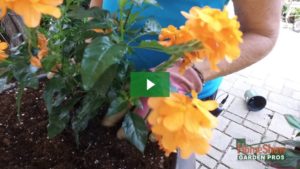Houston Organic Garden Tips & Advice
How To Propagate Annuals So They Survive The Winter
Transcript:
Sherri Harrah:
I’m Sherri with HomeShow Garden Pros, and I’m joined today with Shelby from Nature’s Way Resources and nursery. You know they’re our favorite compost company, but they also have a wonderful garden center. And so we’re here today to talk about things that made it great through the summer, and we want to restore those for next year. So something like coleus. There’s so many beautiful varieties of coleus. So, what’s going to happen when we have our first freeze this year?
Shelby Harper:
So these are going to go… They’re going to die. Whenever they are in this stage of cold weather, they start to go dormant anyway, they start to decline. So what we want to do is we want to take them, we want to cut them, and we want to bring them inside.
Sherri Harrah:
Right, because we have different classifications of plants. We have evergreens that we don’t have to protect, right? Then we have perennials that, if they die from winter, they’re going to come back from the root system.
Shelby Harper:
Right.
Sherri Harrah:
And then herbaceous annuals, like the coleus, they’re going to die no matter if you protect them or not.
Shelby Harper:
Right. Yeah.
Sherri Harrah:
For the most part. They’re supposed to, that’s what they’re supposed to do.
Shelby Harper:
Mm-hmm.
Sherri Harrah:
So, Shelby’s going to show us how to cut them and what we would do to kind of get these going for next spring.
Shelby Harper:
Right. Right.
Sherri Harrah:
So where do we cut them? Where do we begin?
Shelby Harper:
You’re going to take the plant, you’re going to look at it, you’re going to pick a stem that you like. You’re going to go a few nodes down, so you’re going to go a few leaflets down. You’re going to cut right below one of them at a 45 degree angle. And if you have many coleus varieties, you’re going to want to take the different varieties, so you’ll take multiple cuttings.
Sherri Harrah:
Mm-hmm. And anybody can do this, right in your kitchen.
Shelby Harper:
Absolutely.
Sherri Harrah:
You don’t have to have a greenhouse.
Shelby Harper:
No.
Sherri Harrah:
And it’s not dirty, because we’re going to do it right in water, right?
Shelby Harper:
Right. Absolutely. And it’s a beautiful color through the holiday season.
Sherri Harrah:
So you could put it in your kitchen window.
Shelby Harper:
Absolutely.
Sherri Harrah:
Like a bouquet. A bouquet that will grow.
Shelby Harper:
So what you’re going to want to do now… We’ve got our water, our glass of water here. You’re going to want to peel the leaflets back off of the nodes, all the way up to the water line. Otherwise, underneath the water, they could rot.
Sherri Harrah:
Yeah, so you don’t want leaves submerged into the water.
Shelby Harper:
Exactly.
Sherri Harrah:
So anything above where your water line is, just go ahead and take the leaves off.
Shelby Harper:
Exactly. And you can do it pretty quickly.
Sherri Harrah:
And you just plop them in water.
Shelby Harper:
You’ll want to change the water out every week or so at first, and then every three to four weeks. They’re only going to be in your kitchen for two months.
Sherri Harrah:
Two months? Right.
Shelby Harper:
Yeah.
Sherri Harrah:
So we’ll change the water every two weeks, and then, let’s say, after our last chance of frost in March?
Shelby Harper:
Yeah, in March.
Sherri Harrah:
The beginning of March?
Shelby Harper:
You should see some roots on there by that time.
Sherri Harrah:
Uh-huh.
Shelby Harper:
So at that point, you can harden them off in a pot. You could put them straight in the ground.
Sherri Harrah:
Right.
Shelby Harper:
It’s really going to depend, again, after your last frost.
Sherri Harrah:
And then you can have another beautiful display of coleus next year. So for more great tips like this, join us on HomeShow Garden Pros.



